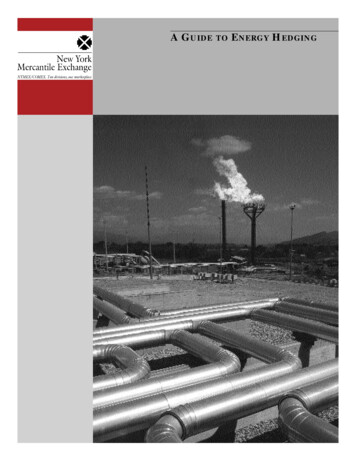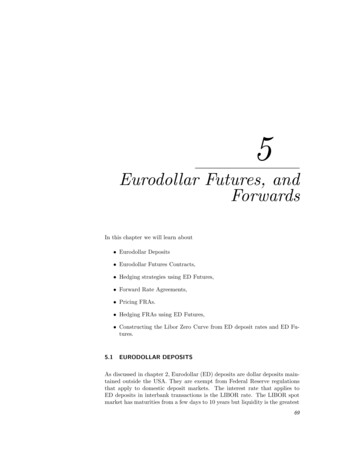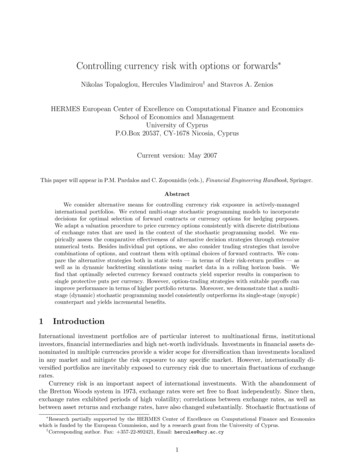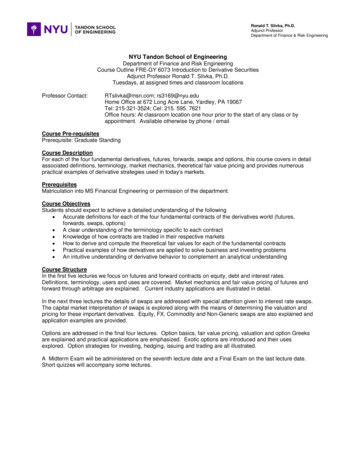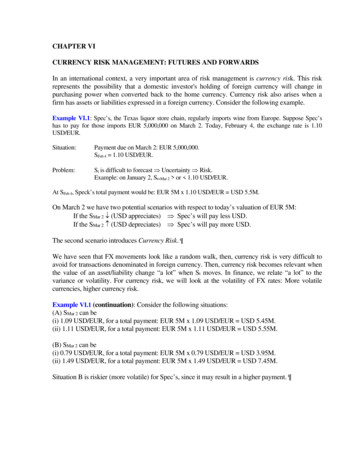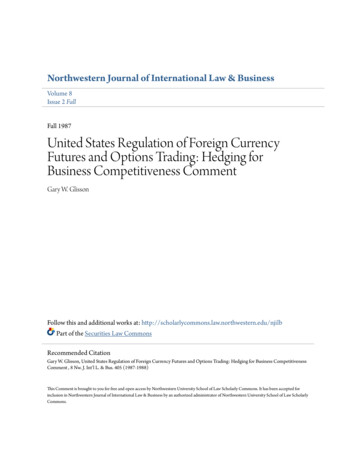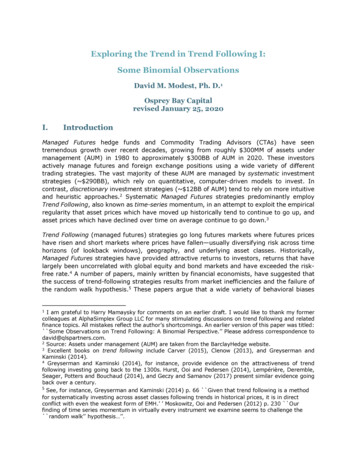
Transcription
Hedging Strategies UsingFuturesChapter 31
The Nature of DerivativesA derivative is an instrument whosevalue depends on the values ofother more basic underlyingvariables.2
Why Derivatives Are ImportantlDerivatives play a key role in transferring risks in theeconomy.lThere are many underlying assets: stocks, currencies,interest rates, commodities, debt instruments, electricity,insurance payouts, the weather, etc.lMany financial transactions have embedded derivatives.lThe real options approach to assessing capital investmentdecisions, which values the options embedded ininvestments using derivatives theory, has become widelyaccepted.3
Futures ContractslA futures contract is an agreement to buyor sell an asset at a certain time in thefuture for a certain price.lBy contrast, in a spot contract there is anagreement to buy or sell the assetimmediately (or within a very short periodof time).4
Exchanges Trading FutureslCME (Chicago Mercantile Exchange) GrouplIntercontinental Exchange (electronic, based in Atlanta)lNYSE Euronext (electronic, US-Europe exchange)lEurex (Europe, based in Germany)lBM&FBovespa (Sao Paulo, Brazil)land many more (see list at end of book)5
Futures PricelThe futures prices for a particular contract is theprice at which you agree to buy or sell at a futuretime.lIt is determined by supply and demand in thesame way as a spot price.lBut we will soon see that arbitrage strategieskeep futures prices within certain bounds.6
Electronic TradinglTraditionally, futures contracts have beentraded using the open outcry system wheretraders physically meet on the floor of theexchange.lThis has now been largely replaced byelectronic trading, and high frequencyalgorithmic trading is becoming anincreasingly important part of the market.7
Examples of Futures ContractsAgreement to:l buy 100 oz. of gold @ US 1750/oz. inDecember.lsell 62,500 @ 1.5500 US / in March.lsell 1,000 bbl. of oil @ US 85/bbl. in April(“bbl” barrel)8
TerminologylThe party that has agreed to buyhas a long position.lThe party that has agreed to sellhas a short position.9
ExamplelJanuary: an investor enters into a longfutures contract to buy 100 oz of gold @ 1,750 per oz in April.lApril: the price of gold is 1,825 per ozlWhat is the investor’s profit or loss?10
Over-the Counter MarketslThe over-the counter market is an importantalternative to exchanges.lTrades are usually between financialinstitutions, corporate treasurers, and fundmanagers.lTransactions are much larger than in theexchange-traded market.11
Ways Derivatives are UsedlTo hedge risk.lTo speculate (take a view on the future direction of themarket).lTo lock in an arbitrage profit.lTo change the nature of a liability.lTo change the nature of an investment without incurring thecosts of selling one portfolio and buying another.12
Futures ContractslAvailable on a wide range of underlyingslExchange tradedlSpecifications need to be defined:llllWhat can be deliveredWhere it can be deliveredWhen it can be deliveredSettled daily13
Forward ContractslForward contracts are similar to futurescontracts, except that they trade in theover-the-counter market.lForward contracts are popular oncurrencies and interest rates.14
Forward Contracts vs FuturesContracts (Table 2.3, page 43)ForwardFuturesPrivate contract between two partiesTraded on an exchangeNot standardizedStandardizedUsually one specified delivery dateRange of delivery datesSettled at end of contractSettled dailyDelivery or final settlement usualUsually closed out prior to maturitySome credit riskVirtually no credit risk15
Options vs Futures/ForwardslA futures/forward contract gives theholder the obligation to buy or sell at acertain price.lAn option gives the holder the right tobuy or sell at a certain price.16
Hedging ExampleslA US company will pay 10 million for importsfrom Britain in 3 months and decides to hedgeusing a long position in a forward contract.lAn investor owns 1,000 shares currently worth 28 per share.A two-month put with a strike price of 27.50costs 1.The investor decides to hedge by buying 10contracts.ll17
Long & Short HedgeslA long futures hedge is appropriate whenyou know you will purchase an asset inthe future and want to lock in the price.lA short futures hedge is appropriatewhen you know you will sell an asset inthe future and want to lock in the price.18
Arguments in Favor of HedgingThe general idea:Companies should focus on the mainbusiness that they are in, and takesteps to minimize risks arising frominterest rates, exchange rates, andother market variables.19
Arguments against HedginglShareholders are usually well diversified andcan make their own hedging decisions.lIt may increase risk to hedge when competitorsdo not.lExplaining a situation where there is a loss onthe hedge and a gain on the underlying can bedifficult.20
Profit from a Long Forward orFutures PositionProfitPrice of Underlyingat Maturity21
Profit from a Short Forward orFutures PositionProfitPrice of Underlyingat Maturity22
Convergence of Futures to Spot(Hedge initiated at time t1 and closed out at time t2)SpotPriceFuturesPriceTimet1t223
Basis RisklBasis is the difference betweenspot & futures prices.lBasis risk arises because of theuncertainty about the basiswhen the hedge is closed out.24
Long Hedge for Purchase of an AssetlDefineF1 : Futures price at time hedge is set upF2 : Futures price at time asset is purchasedS2 : Asset price at time of purchaseb2 : Basis at time of purchaseCost of assetS2Gain on FuturesF2 F1Net amount paidS2 (F2 F1) F1 b225
Short Hedge for Sale of an AssetDefineF1 :F2 :S2 :b2 :Futures price at time hedge is set upFutures price at time asset is soldAsset price at time of saleBasis at time of salePrice of assetS2Gain on FuturesF1 F2Net amount receivedS2 (F1 F2) F1 b226
Choice of ContractlChoose a delivery month that is as close aspossible to, but later than, the end of the lifeof the hedge.lWhen there is no futures contract on theasset being hedged, choose the contractwhose futures price is most highly correlatedwith the asset price (or highest R2 inregression).27
Optimal Hedge RatioProportion of the exposure that should optimally behedged ish ρσSσFwhereσS is the standard deviation of ΔS, the change in the spotprice during the hedging period,σF is the standard deviation of ΔF, the change in thefutures price during the hedging periodρ is the coefficient of correlation between ΔS and ΔF.28
Optimal Number of ContractsQASize of position being hedged (units)QFSize of one futures contract (units)VAValue of position being hedged ( spot price time QA)VFValue of one futures contract ( futures price times QF)Optimal number of contracts ifno tailing adjustmenth *Q A QFOptimal number of contractsafter tailing adjustment to allowfor daily settlement of futuresh *V A VF29
ExamplellAirline will purchase 2 million gallons of jet fuelin one month and hedges using heating oilfutures.From historical data σF 0.0313, σS 0.0263,and ρ 0.9280.0263h 0.928 0.77770.0313*30
Example continuedl The size of one heating oil contract is 42,000 gallonslllThe spot price is 1.94 and the futures price is 1.99(both dollars per gallon) so thatV A 1.94 2,000,000 3,880,000V F 1.99 42,000 83 ,580Optimal number of contracts assuming no dailysettlement 0.7777 2,000,000 42,000 37 .03Optimal number of contracts after tailing 0.7777 3,880, 000 83,580 36.1031
Example continuedSuppose you tailed the hedge. One month later, the oil (spot) price is upto 2.45/gal and the futures price is 2.63/gal.§ Without the futures contracts protection, how much would you have topay today for the 2,000,000 gallons of oil?§ Compared to the spot price from one month ago, how much more doyou need to pay now (in dollars)? And percentage-wise?§ What is your gain on the long futures contracts position? (in dollars)§ Combining the spot and futures market (i.e. expensive payment in thespot market but partially reduced by your gains on the futures), what isyour net payment for oil today?§ How much more is your net payment today compared to what youwould have paid one month ago had you purchased the oil immediately(spot market) back then?§ How much more is it percentage-wise?32
Example continuedSuppose you tailed the hedge. One month later, the oil (spot) price is up to 2.45/gal and the futures price is 2.63/gal.§ Without the futures contracts protection, you would have to pay now2,000,000 x 2.45 4,900,000.§ Compared to the spot price from one month ago, you must pay now(2.45-1.94) x 2,000,000 4,900,000 - 3,880,000 1,020,000.§ Percentage-wise, that translates into 1,020,000 / 3,880,000 26% more.§ The gain on the futures contracts is 36 x (2.63-1.99) x 42,000 967,680.§ You pay in the spot market 4,900,000 but receive 967,680 from thefutures market, hence your net payment for oil is 3,932,320.§ Compared to one month ago had you purchased the oil immediately (spotmarket) back then, it is an increase of 3,932,320 - 3,880,000 52,320.§ Percentage-wise, it is a small increase of 52,320/ 3,880,000 1.35%.33
Hedging Using Index Futures(Page 65)To hedge the risk in a portfolio, thenumber of contracts that should beshorted is:VAβVFwhere VA is the current value of theportfolio, β is its beta, and VF is the currentvalue of one futures ( futures pricetimes contract size)34
Example of index futures hedgelllllFutures price of S&P 500 is 1,010Size of portfolio is 5,050,000Spot price of S&P 500 is 1,000Beta of portfolio is 1.5One contract is on 250 times the indexWhat position in futures contracts on theS&P 500 is necessary to hedge theportfolio?35
Example of index futures hedge§One futures contract is for the delivery of 250 times the market index.§Therefore one must shortN* 1.5 x 5,050,000 / (250x1,010)N* 30 index futures contracts.36
Example of index futures hedge§§§§§§Excluding dividends and ignoring the risk-free rate,assume that the S&P 500 index has now dropped to 900and that the index futures price is now 902.What is the rate of return on the S&P 500? (% loss)What is the rate of return on your portfolio? (assumedriven by β)What is your new portfolio value?What are your dollar gains on your short index futuresposition?What is your net total portfolio value once you add thegains from the futures contracts protection? How does itcompare with the initial value of your portfolio?37
Example of index futures hedgeThe rate of return on the S&P 500 is (900-1000)/1000 sothe index experienced a 10% loss.§ Assuming the portfolio returns are driven by β, theportfolio should experience a loss of β(-10%). Thereforethe portfolio should return 1.5(-10%) -15%.§ The new portfolio value is the original value minus 15%.In other words, it is: 5,050,000 x (1-.15) 4,292,500.§ The dollar gains on the short index futures position are:30 x (1,010 - 902) x 250 810,000§ Your net combined total position is now therefore worth: 4,292,500 810,000 5,102,500(slightly above the initial portfolio value: the hedge worked!)§38
Changing BetalIn the previous slides we attempted to reduce the beta of theportfolio to zero, i.e. to eliminate the market risk completely.lHowever, index futures contracts are sometimes used to modifybeta to a value different from zero: either to reduce beta, or toincrease beta.llTo reduce β to β*, one must take a short position in index futurescontracts. The number of contracts to short is (β-β*)VA/VF.To increase β to β*, one must take a long position in index futurescontracts. The number of contracts to buy is (β*-β)VA/VF.39
Changing Beta: Number of Contracts§Going back to the previous example, assumeyou instead would have wanted to decreaseyour portfolio β from 1.5 to 0.75.You must therefore shortN* (1.5-0.75) x 5,050,000 / (250x1,010)orN* 15 index futures contracts.§40
Changing Beta: Scenario and Check§§§§§§§§Excluding dividends and ignoring the risk-free rate, assume that theS&P 500 index has now dropped to 900 and that the index futuresprice is now 902.What is the rate of return on the S&P 500? (% loss)What is the rate of return on your portfolio? (assume driven by β)What is your new portfolio value?What are your dollar gains on your short index futures position?What is your net total portfolio value once you add the gains fromthe futures contracts protection?What is your net total return overall? (net total portfolio value nowdivided by initial portfolio value, minus one)Divide your net total return by the S&P 500 return. Is it close to abeta of 0.75?41
Changing Beta: Scenario and Check§§§§§§§The index experienced a 10% loss, same as before.The portfolio like before, returned 1.5(-10%) -15%.The new value is 5,050,000 x (1-.15) 4,292,500The dollar gains on the short index futures position are:15 x (1,010 - 902) x 250 405,000Your net combined total position is now therefore worth: 4,292,500 405,000 4,697,500Net total return is: 4,697,500/ 5,050,000 – 1 -6.98%If we divide it by the market return to get our net effectivebeta, we obtain: -6.98%/-10% 0.70 (close to ourtargeted beta of 0.75 !)42
Why Hedge Equity ReturnslSometimes you may want to be out of themarket for a while. Hedging avoids the costs ofselling and repurchasing the portfolio.lSuppose stocks in your portfolio have anaverage beta of 1.0, but you feel they have beenchosen well and will outperform the market inboth good and bad times. Hedging ensures thatthe return you earn is the risk-free return plusthe excess return of your portfolio over themarket.43
Stack and RolllWe can roll futures contracts forward to hedgefuture exposures.lInitially we enter into futures contracts to hedgeexposures up to a time horizon.lJust before maturity we close them out andreplace them with a new contract reflecting thenew exposure.44
Liquidity Issues (See Business Snapshot 3.2)lIn any hedging situation, there is a danger that losses willbe realized on the hedge while the gains on theunderlying exposure are unrealized.lThis can create liquidity problems.lYou might have a paper profit on the underlying asset buta loss on the futures contract that could trigger margincalls and therefore mandatory immediate cash outflows.45
Why Derivatives Are Important l Derivatives play a key role in transferring risks in the economy. l There are many underlying assets: stocks, currencies, interest rates, commodities, debt instruments, electricity, insurance payouts, the weather, etc. l Many financial transactions have embedded derivatives. l


